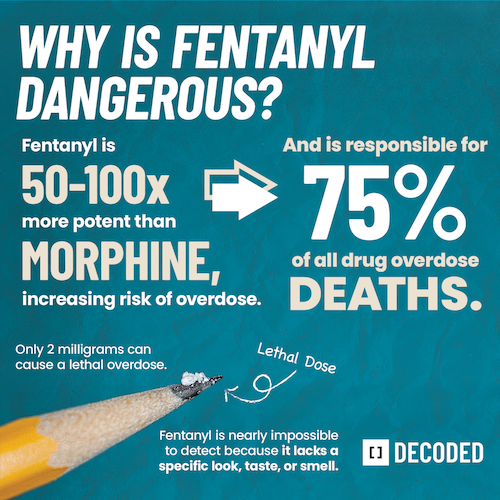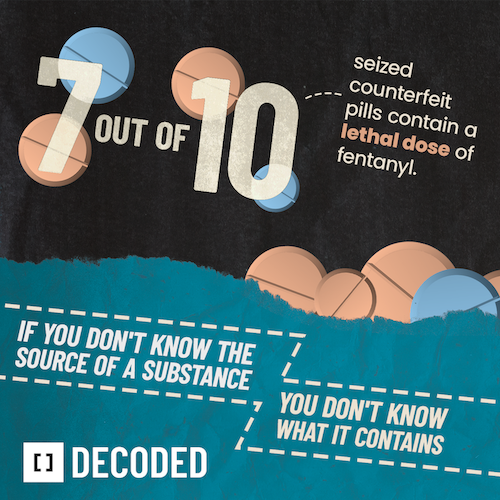What Is Fentanyl?
Fentanyl is a powerful synthetic opioid that is similar to morphine but is 50 to 100 times more potent.1 Fentanyl has been found in substances such as heroin, meth, MDMA (ecstasy/molly), cocaine, and other recreational drugs due to its low cost. It is estimated that illegally-made fentanyl may be responsible for 75% of all drug overdose-related deaths.2
Why Is Fentanyl Dangerous?
The high potency of fentanyl greatly increases the risk of overdose. People may not be aware they are consuming it because it can be disguised as other drugs and is nearly impossible to detect without testing. Fentanyl has no specific look or smell, and without being aware of its presence, it can be easy to underestimate how much is being consumed, resulting in overdose.3 As little as a grain of fentanyl can be enough to cause harm or even a fatal overdose.


What Are The Signs Of An Overdose?
An overdose occurs when a drug produces serious adverse effects and life-threatening symptoms. When people overdose on fentanyl, their breathing can slow or stop. This decreases the amount of oxygen that reaches the brain, leading to a coma, permanent brain damage, and even death.1

Signs of overdose include
- Severe sleepiness/not being able to stay awake
- Cold, slimy skin
- Trouble breathing, walking, or talking
- Slow heartbeat/slow or no pulse
- Slow or no breathing, gurgling
- Skin looks pale, gray, blue, and feels cold
- Body is limp, will not respond to sound or stimulation
If you suspect someone has overdosed, give them naloxone and call 911. Naloxone is a medicine that can be given to a person to reverse a fentanyl overdose. Even if you aren’t sure someone is overdosing, you can give them naloxone anyway. Giving naloxone to someone who is not overdosing will not harm them, and if they are overdosing, you could save their life. To learn more, read our blog What Is Naloxone and Who Should Carry It?

Resources
- Good Samaritan Laws - Don’t be Afraid to Ask for Help
- National Institute on Drug Abuse - Naloxone Drug Facts
Sources:
1. NIDA. (2021, June). Fentanyl drug facts. National Institute on Drug Abuse; National Institute of Health. https://nida.nih.gov/publications/drugfacts/fentanyl
2. CDC. (2024, December 12). State unintentional drug overdose reporting system (SUDORS). Centers for Disease Control; U.S. Department of Health and Human Services. https://www.cdc.gov/overdose-prevention/data-research/facts-stats/sudors-dashboard-fatal-overdose-data.html?CDC
3. CDC. (2024, April 2). Fentanyl facts. Stop Overdose; Centers for Disease Control. https://www.cdc.gov/stop-overdose/caring/fentanyl-facts.html
